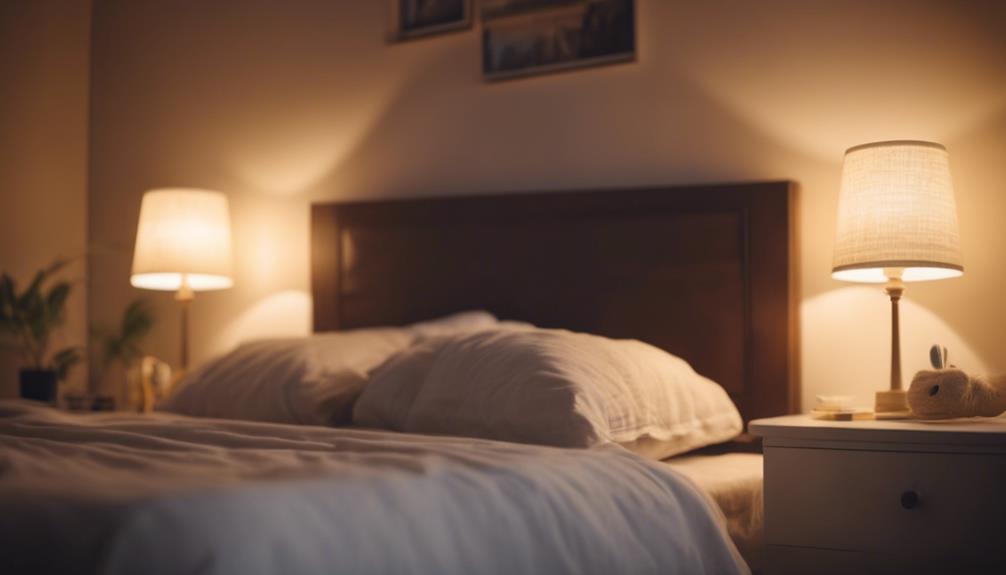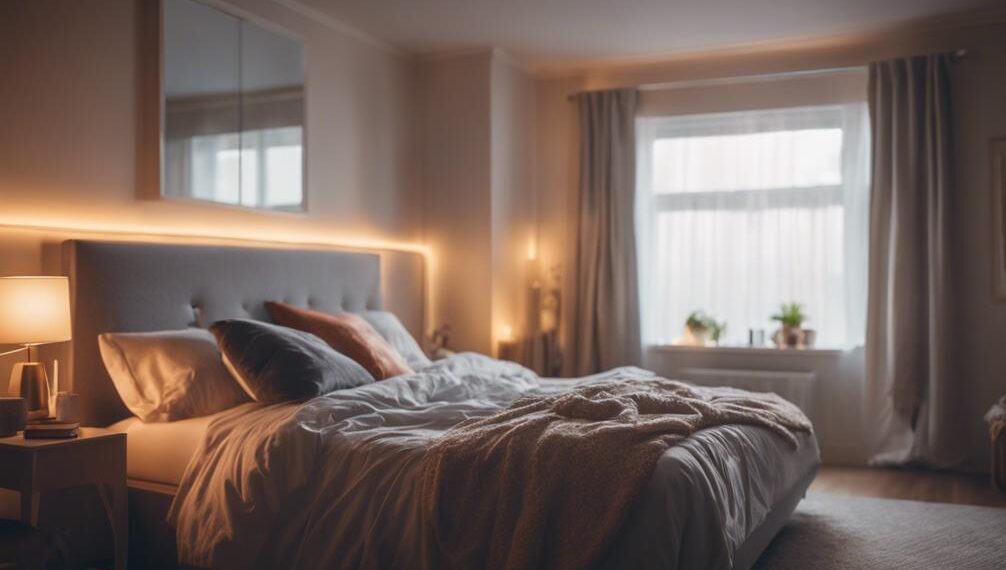We've all experienced the struggle of waking up groggy and lethargic, even after a full night's sleep. But what if the solution to a more restful sleep lies in something as simple as the lighting in our homes?
Circadian rhythm lighting solutions have been gaining popularity for their potential to optimize our sleep patterns. This innovative approach to lighting aligns with our body's natural biological clock, but how exactly does it work, and what benefits can it offer?
Let's explore the fascinating world of circadian rhythm lighting and its impact on our sleep quality.
Key Takeaways
- Mimic natural light patterns to regulate circadian rhythms for improved sleep quality.
- Use warm-toned, dimmable lights to reduce blue light exposure and signal the body for rest.
- Incorporate human-centric lighting to enhance well-being, productivity, and immunity.
- Strategically adjust light color and intensity throughout the day to optimize sleep and mood.
Understanding Circadian Rhythms

Understanding circadian rhythms is crucial for optimizing our sleep-wake cycles and overall well-being. Our body clock regulates various physiological processes, including sleep patterns and alertness levels. This internal clock follows a roughly 24-hour cycle, influenced by external cues like light and darkness. Melatonin, a hormone that induces sleep, is produced by the body in response to darkness, helping us feel drowsy and ready for rest. As morning approaches and light increases, melatonin production decreases, and we become more alert.
Our sleep patterns are intricately tied to these circadian rhythms, and disruptions can lead to issues with both our physical and mental health. By understanding how our body clock functions, we can make informed choices to support it. Maintaining a consistent sleep schedule, exposing ourselves to natural light during the day, and limiting exposure to artificial light at night are all ways to align our habits with our circadian rhythms. By prioritizing our body's natural rhythm, we can enhance the quality of our sleep and overall wellness.
Impact of Light on Sleep

Our body's response to light plays a significant role in regulating our sleep patterns and overall well-being. Light, especially blue light, influences our internal body clock, known as the circadian rhythm, which helps us determine when to sleep and when to wake up. Exposure to blue light, commonly emitted by electronic devices and energy-efficient lighting, can suppress the production of melatonin, a hormone that regulates sleep. This suppression can lead to difficulties falling asleep and result in poorer sleep quality.
To optimize sleep quality, it's essential to manage our exposure to blue light, especially in the evening hours. Limiting screen time before bed, using warm-toned light bulbs, and incorporating dimmer switches can help reduce the impact of blue light on our circadian rhythm. Creating a sleep-friendly environment by dimming lights closer to bedtime can signal to our bodies that it's time to wind down and prepare for restorative sleep. By understanding how light affects our sleep patterns, we can make informed choices that promote better sleep quality and overall well-being.
Human Centric Lighting Benefits

Exploring the benefits of human-centric lighting can enhance our understanding of how light impacts our daily routines and well-being. When it comes to mood regulation and productivity, human-centric lighting plays a crucial role in optimizing these aspects of our lives. The following benefits illustrate the importance of incorporating human-centric lighting solutions:
- Mood Regulation: Human-centric lighting mimics the natural changes in daylight, helping to regulate our mood and emotions throughout the day.
- Productivity: By aligning our lighting with our circadian rhythms, human-centric lighting can boost focus, alertness, and overall productivity.
- Health Benefits: Exposure to human-centric lighting, which closely resembles natural light, can have positive effects on our physical health, including better sleep patterns and enhanced immune function.
- Natural Light: Incorporating human-centric lighting allows us to experience the benefits of natural light indoors, promoting a sense of well-being and connection to the external environment.
These advantages highlight the significant impact that human-centric lighting can have on our daily lives, emphasizing the importance of considering lighting solutions that prioritize our well-being and productivity.
Choosing the Right Light Bulbs

Selecting the appropriate light bulbs is crucial for optimizing human-centric lighting solutions in indoor environments. When choosing light bulbs for circadian rhythm lighting, consider the color temperature and dimmable options. Color temperature plays a significant role in mimicking natural light throughout the day. For morning and daytime lighting, opt for bulbs with a cooler color temperature (5000-6500 Kelvin) to promote alertness and productivity. In the evening, warmer color temperatures (2000-3000 Kelvin) help signal the body that it's time to wind down and prepare for sleep.
Dimmable options are essential for adjusting the intensity of light based on the time of day and individual preferences. Dimming the lights in the evening can help create a relaxing atmosphere conducive to better sleep. Additionally, having the ability to dim the lights gradually as bedtime approaches can signal the body to produce melatonin, the hormone responsible for regulating sleep.
Implementing Lighting Solutions

To effectively implement lighting solutions that align with circadian rhythms, it's essential to consider factors such as placement, intensity, and timing of light exposure in indoor environments. When optimizing lighting for circadian health, the following aspects are crucial:
- Lighting placement: Position light sources strategically to mimic natural sunlight patterns throughout the day, helping regulate the body's internal clock.
- Color temperature: Choose lighting with varying color temperatures that shift from warm tones in the evening to cooler tones during the day to support alertness and relaxation at appropriate times.
- Dimming capabilities: Incorporate dimmable lights to adjust brightness levels according to the time of day, promoting melatonin production in the evening and enhancing alertness during daytime hours.
- Smart controls: Utilize smart lighting systems that can be programmed to automatically adjust intensity and color temperature based on preset schedules, simplifying the process of maintaining a circadian-friendly environment.
Implementing these lighting solutions thoughtfully can significantly improve sleep quality and overall well-being by harmonizing indoor lighting with the body's natural rhythms.
Frequently Asked Questions
How Can Circadian Rhythm Lighting Solutions Improve Productivity and Focus During the Day?
Improving productivity and focus during the day can be achieved by utilizing circadian rhythm lighting solutions. These solutions help regulate our body's internal clock, enhancing energy levels, concentration, mood, and alertness.
Are There Any Specific Recommendations for Adjusting Lighting in Different Rooms of the House to Optimize Sleep?
When it comes to optimizing sleep, adjusting brightness and room ambience play key roles. By fine-tuning lighting in different rooms, we can create a sleep-friendly environment. Dimming lights gradually in the evening signals our bodies it's time to wind down.
Cool-toned lights during the day and warm-toned lights in the evening mimic natural light changes. These simple adjustments can help us achieve a more restful night's sleep.
Can Circadian Rhythm Lighting Help With Reducing Symptoms of Jet Lag or Shift Work Fatigue?
Circadian rhythm lighting can certainly aid in reducing symptoms of jet lag or shift work fatigue. By aligning our lighting exposure with our internal body clock, we can help our bodies adjust to new time zones and shift work schedules more smoothly.
This can enhance travel adaptation and improve night shift strategies. Using circadian lighting solutions strategically can positively impact our sleep-wake cycles and overall well-being in these scenarios.
Is There a Specific Time Window During the Day When Exposure to Certain Types of Light Is Most Beneficial for Regulating Sleep Patterns?
When considering light exposure for regulating sleep patterns, it's vital to understand the impact on melatonin production.
Various studies suggest that exposure to certain types of light during the morning can help improve alertness and set our internal clocks for a better sleep-wake cycle.
This aligns with the saying, 'Morning light, sleep tight.'
Thus, strategic light exposure during the day can positively influence our sleep patterns and overall well-being.
Are There Any Studies or Research That Show the Long-Term Effects of Using Circadian Rhythm Lighting Solutions on Overall Health and Well-Being?
Research findings have shown that using circadian rhythm lighting solutions can have significant health benefits. Long-term effects include improved sleep quality, mood regulation, and overall well-being.
Studies indicate that exposure to these lighting systems can positively impact our circadian rhythms, leading to better health outcomes.
The well-being impact of incorporating such lighting solutions into daily routines can be substantial, supporting a healthier lifestyle and promoting better sleep habits.
Are Circadian Rhythm Lighting Solutions the Best Option for Improved Sleep?
When it comes to improving sleep, circadian rhythm lighting solutions are considered the best option. This type of lighting mimics the natural light cycle, helping regulate melatonin production for better sleep. Investing in the best lighting solutions for sleep can make a significant difference in overall sleep quality.
Conclusion
In conclusion, optimizing sleep with circadian rhythm lighting solutions is essential for maintaining a healthy sleep-wake cycle.
By understanding the impact of light on our sleep patterns and implementing human-centric lighting, we can improve our overall well-being.
When we choose the right light bulbs and create a suitable environment, we align our internal clock with the external world, leading to better sleep quality and overall health.
Let's illuminate our way to a restful night's sleep.








